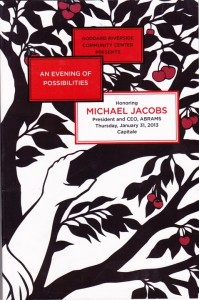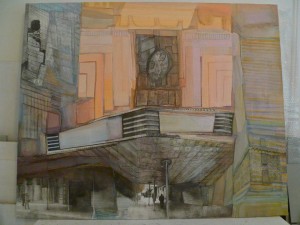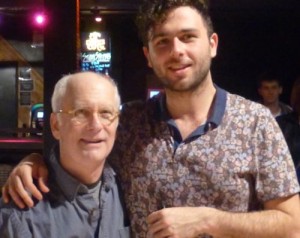 Last Thursday night the publishing industry finally had a chance to celebrate the career of Michael Jacobs, currently head of Abrams, who earlier had successful tenures at Scholastic, Simon & Schuster and Viking Penguin. I write “finally” because the event feting Michael–which was also designed to give his friends and colleagues the chance to contribute money for the good work of Goddard Riverside Community Center, a key provider of social services on the west side of Manhattan–was originally scheduled for Monday, October 29th, the night that Superstorm Sandy hit NYC.
Last Thursday night the publishing industry finally had a chance to celebrate the career of Michael Jacobs, currently head of Abrams, who earlier had successful tenures at Scholastic, Simon & Schuster and Viking Penguin. I write “finally” because the event feting Michael–which was also designed to give his friends and colleagues the chance to contribute money for the good work of Goddard Riverside Community Center, a key provider of social services on the west side of Manhattan–was originally scheduled for Monday, October 29th, the night that Superstorm Sandy hit NYC.
In the aftermath of the devastating storm, I, and none of the friends I had been hoping to see that night, were sure that the event would be rescheduled. But just before Christmas it was announced the benefit would still be held, on January 31st. I was pleased, as many were, that we’d still have the chance to formally toast the honoree. On a side note, I picked up something interesting about event planning in NYC, and which may have pertained in this instance. A friend who seemed knowledgeable indicated that because the mayor’s office had officially shut the city down on the Sunday–shuttering subways and announcing school closures, all well in advance of the storm’s arrival–the bond that had been taken out on the event, the insurance against last-minute cancellation of it–did not have to be paid, at least not in full. The venue, Capitale on Bowery near Grand Street, never had to unlock its doors or turn on the lights, the caterer didn’t have to prepare a canape or uncork a bottle of wine, and the waitstaff didn’t have to don their livery and report for work. Thus, it seems that financial sacrifices for all parties were minimized and a make-up date could be scheduled, with donors’ contributions all going toward the benefit of Goddard Riverside, such a valuable community resource.
Capitale is a grand venue–a former bank–designed by architect Stanford White.* The high, vaulted space looks like it could have been the set for a depression-era film, such as “American Madness,” where Walter Huston plays a bank president trying to avert a crippling ‘run’ on his institution. The evening began with a cocktail hour, where almost 500 guests began assembling right at the opening time of 6 PM. Even in this huge space it became cramped quickly, making it a challenge to get around and say hello to the friends and familiar faces one hadn’t seen in a long time. Still, it was very convivial, even shoulder to shoulder, elbow to elbow, all at close quarters. I just wouldn’t have wanted to be one of the waiters serving those canapes. I saw Michael Jacobs and told him how glad I was this event was at last coming off. He was beaming. As with many people I know in the book business, I met Michael, then with Viking, sometime between 1978-85 when with my family I ran Undercover Books, a 3-store chain of indie bookstores in Cleveland, Ohio. Abrams was then known for publishing the most opulently printed art and coffee table books, and our store did great business with their whole list. The company has changed a lot since, but Abrams remains one of the finest publishers of illustrated books, along with childrens’ books and a range of nonfiction.
Around 7:00 we were asked to head through a curtain dividing the room and find our tables. I was at #37–a prime number, I thought–at a table put together by my friend, longtime rights maven, publisher, and agent, Mildred Marmur.** The program portion of the evening kicked off with an amusing short film made by Michael’s exceptional executive assistant, Merle Brown, with a crew made up of family members of hers. It was a scenario where Merle, as dinner benefit wrangler ‘stalks’ Chronicle Books president, Jack Jensen, to enroll his support. Jack continually dodges her and pleads with her to leave him alone. It was quite funny, with Merle speaking directly to the camera at points, feigning fatigue from chasing Jack all over, in apartment building lobbies, at an airport, and on the street. When it ended Merle introduced Jack, who quickly assured us he wasn’t really reluctant to be feting his good friend Michael. He and Michael had gotten to know each other around 1980, when they roomed together. Jack was followed by a number of speakers, including Abrams author Jeff Kinney, creator of the Diary of a Wimpy Kid series. Kinney explained how glad he was when Michael and he had capitalized on the launch of Diary of a Wimpy Kid: Cabin Fever in 2011 to benefit programs at Goddard Riverside. The materials handed out to guests included Goddard Riverside’s annual report for 2011, from which I learn that the Center’s roots reach back to the settlement house movement of the 19th century, in their case to 1887. Their annual budget is more than $20 million, supporting a day care center in a brownstone; a mobile mental health unit; a residence for low-income adults; and a center devoted to training college counseling professionals all over the city. There is also their signature book industry event, the annual holiday book fair, to which publishers contribute thousands of books, drawing New Yorkers every year.
Amid the remarks, salad, dinner and dessert were served and eaten. The program concluded when Michael was introduced by JP Leventhal, of Black Dog & Leventhal Publishers, and he took to the podium. It was a warm talk, full of affection for the book business that’s given him his career, and fondness for the many people who’ve befriended him along the way, especially for the folks who’d organized the dinner, even after its near-cancellation. He thanked lots of people by name, told us that more than $600,000 had been raised for Goddard Riverside, gave shout-outs to his family, and closed by reading a Wallace Stevens poem.
In a long line to retrieve my coat and bag, I found myself waiting with Penguin editor-in-chief Kathryn Court, and Elliott Figman, executive director of Poets & Writers, whom I had never met before, though I enjoy his magazine. The three of us discussed how Sandy had displaced us to varying extents. I was tickled to learn that Elliott, who went to Oberlin College, clearly remembered Robert Fuller, now my author client, who was president of Oberlin for 4 years. We enjoyed meeting and agreed to talk again another time.
It was a great night for Michael Jacobs, and a grand night for publishing, affirming once again that the book business is still a collegial world, filled with people who care for one another, and for their city.
*I recall that the ill-fated White was played by Norman Mailer in Ragtime, the 1981 movie adapted from E.L. Doctorow’s historico-literary novel. The plot covered, in part, the murder of White by Harry Thaw, who was jealous of White’s affair with his wife Evelyn Nesbit, played by Elizabeth McGovern, nowadays playing Cora in “Downton Abbey.”
**In 1975, while Marmur was Director of Subsidiary Rights at Random House, the company published Ragtime in hardcover. She auctioned the rights to Doctorow’s novel to Bantam, for what was then the largest deal ever made for a paperback reprint of a literary novel, $1,850.000.
Please click through here to see all photos.
 In the past year I’ve blogged twice about the announcement and expectation that Austin-based Alamo Drafthouse Cinema is really going to renovate the Metro theater in my Manhattan neighborhood and show movies there. However, despite press releases from Alamo that I’ve cited in my coverage, there’d been no sign of progress, leaving myself and others in the area unsure if it’s really going to happen. Finally, a banner on the old marquee I spotted the other day (pictured at the left) seems to make their plans clear at last: They’ll be opening in 2014. Here’s what I wrote about Alamo last summer:
In the past year I’ve blogged twice about the announcement and expectation that Austin-based Alamo Drafthouse Cinema is really going to renovate the Metro theater in my Manhattan neighborhood and show movies there. However, despite press releases from Alamo that I’ve cited in my coverage, there’d been no sign of progress, leaving myself and others in the area unsure if it’s really going to happen. Finally, a banner on the old marquee I spotted the other day (pictured at the left) seems to make their plans clear at last: They’ll be opening in 2014. Here’s what I wrote about Alamo last summer:






